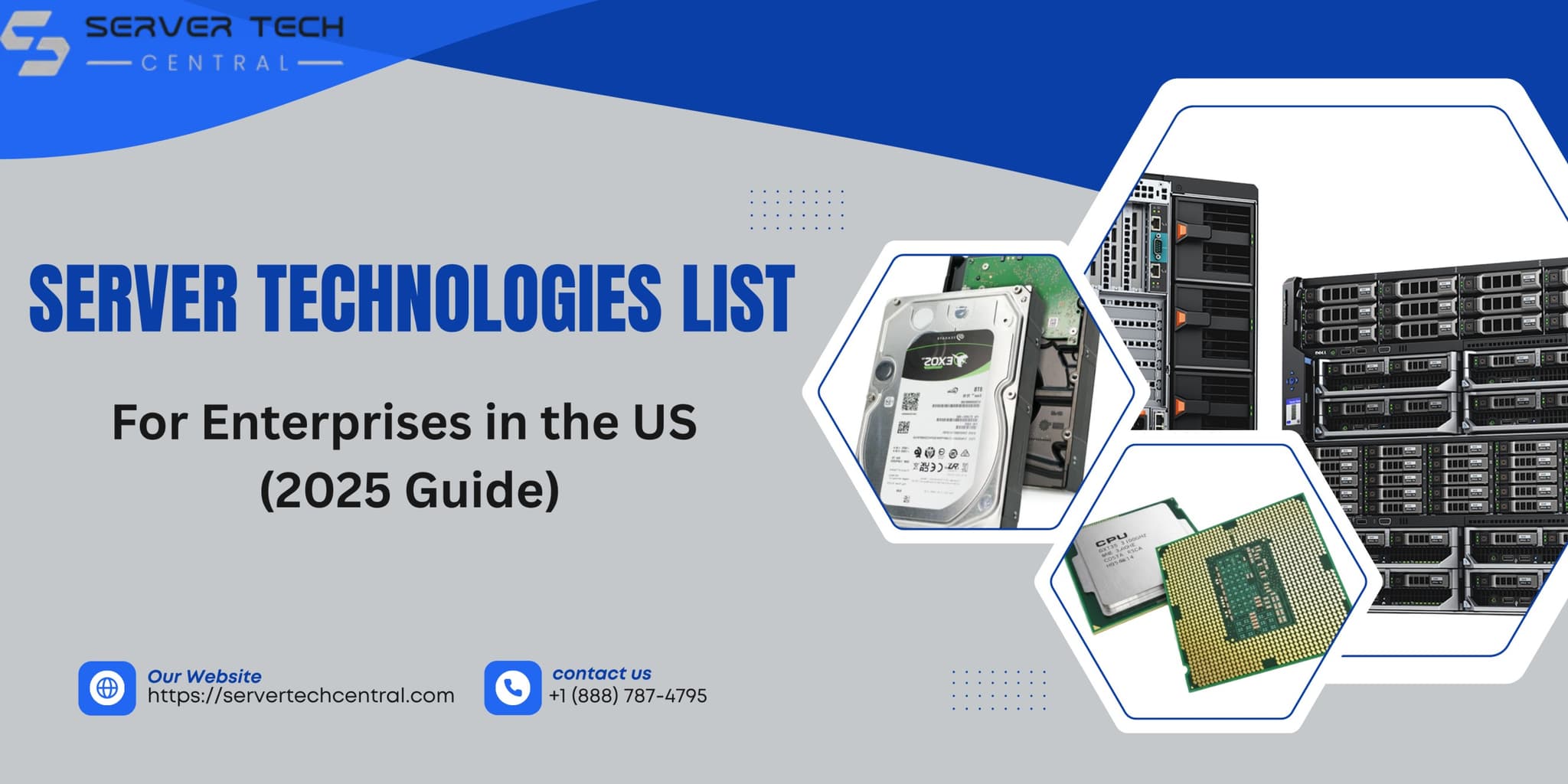Top Server Technologies List for Enterprises in the US (2025 Guide)

Server Tech Central
10/27/2025

In 2025, the enterprise digital environments are experiencing rapid transformations. With rising demands for speed, scale, and flexibility, server infrastructure is now more essential than ever for U.S. businesses.
Modern workloads, including artificial intelligence (AI), edge computing, real-time analytics, and hybrid cloud operations, are challenging traditional server architectures. As a result, enterprises are adopting next-generation server technologies that provide increased performance, improved energy efficiency, and greater flexibility to support dynamic business needs.
This article covers the list of top server technologies that are being adopted by US enterprises in 2025. Read along to know more.
What are Server Technologies?
Server technologies cover the hardware and software systems that enable the servers to perform their crucial role in enterprise computing. Servers are powerful computers that manage, store, and process data efficiently. They support a wide range of applications and services.
Over the years, server technologies have evolved significantly, leading to advanced processors, high-speed storage solutions, and intelligent management tools. These innovations have made it possible for servers to handle complex workloads with greater speed and efficiency.
Modern server technologies also give significance to cybersecurity, energy efficiency, and remote manageability. These are the essential features in today’s environment, where data protection, sustainability goals, and distributed operations are top priorities.
Top Server Technologies List in 2025
The enterprise IT demands have started evolving rapidly. Businesses are investing in solutions that support energy efficiency, scalability, and security. Below is a categorized list of the top server technologies that are defining enterprise strategies this year:
AI-Optimized Servers: The AI-optimized servers combine GPUs, TPUs, and accelerators to support deep learning and real-time inference. These servers are built to handle high-computation tasks effectively.
High-Core Count CPUs (Intel, AMD, ARM): CPUs with more cores, such as AMD EPYC, Intel Xeon Scalable, or ARM-based chips, deliver impressive performance for virtualization and databases, improving energy efficiency.
Edge Computing Servers: Edge computing servers are powerful systems located close to the data source. They reduce latency, improve responsiveness, and minimize reliance on cloud connectivity. These servers are necessary for IoT, smart manufacturing, and low-latency applications.
Hardware-Level Security: As cyber threats are growing rapidly, enterprises are prioritizing servers with integrated security features. This includes secure boot, hardware root of trust, silicon-level encryption, and real-time threat detection capabilities. It helps protect sensitive data and maintain obedience.
NVMe and PCIe Gen5 Storage: NVMe (Non-Volatile Memory Express), joined with PCIe Gen5 interfaces, delivers ultra-fast data transfer and reduced latency, critical for performance-intensive applications like analytics, virtualization, and AI.
Liquid & Immersion Cooling: Liquid and immersion cooling techniques are used to keep high-performance servers cool while reducing energy consumption. This is beneficial for AI data centers and edge locations.
Growing Demand for Server Technologies in Enterprises
As digital operations become essential to staying competitive, enterprises are now shifting their focus toward building a smarter and more responsive IT infrastructure. This shift is not just about using new techniques; rather, it’s about redesigning the entire IT foundation, with the server playing a central role in that transformation.
The increase in remote work, the growth of edge computing, and the explosion of data from connected devices are all contributing to a significant rise in infrastructure demands. Today’s enterprises rely on advanced server technologies and intelligent network switches that can scale quickly, handle diverse workloads, and ensure seamless connectivity across decentralized environments. Together, these technologies enable high performance, reliability, and efficient data management across modern IT infrastructures.
Rather than choosing servers based on processing power, enterprises now rely on the server technologies list to identify solutions that meet broader requirements. This growing demand is redefining what modern server infrastructure looks like and how it supports evolving business needs.
Leading Server Vendors in the US (2025)
U.S. enterprises are forming partnerships with top-tier server vendors that offer flexibility and innovation. Below are the major ones and their strengths:
Dell Technologies
One of the largest server vendors in the US
AI-optimized PowerEdge servers with Nvidia GPU support
Advanced cooling solutions for high-density workloads
Strong enterprise support and integration capabilities
Hewlett-Packard Enterprise (HPE)
Known for hybrid cloud and composable infrastructure platforms
ProLiant Gen11 servers for AI, virtualization, and edge computing
Scalable, consumption-based IT model
Excellent lifecycle management and software integration
IBM
Offers enterprise-class Power Systems for AI and analytics
Strong in security, hybrid cloud, and mission-critical applications
Deep integration between hardware and enterprise software stacks
Ideal for organizations with complex infrastructure needs
Lenovo
Energy-efficient, cost-effective servers for enterprise workloads
Solid global support and consistent reliability
Cisco
Combines computing and networking via its Unified Computing System (UCS)
Ideal for converged infrastructure and edge deployments
Strong in data center environments and edge-ready deployments
How to Choose the Right Server Technology for Your Enterprise
With so many innovations in the server technology, selecting the right solution can be challenging. The following are the key points that would help you choose the best server technology for your organization:
Define Your Workload Requirements: Acknowledge the specific applications and workloads (AI, big data, edge computing, etc.) your servers need to support.
Consider Scalability & Flexibility: Choose solutions that allow easy expansion and can work as your business grows.
Prioritize Built-in Security: Observe features like secure boot, encryption, and hardware-level protection to strengthen cybersecurity.
Evaluate Energy Efficiency: Go for energy-conscious servers that reduce power usage and support eco-friendly projects.
Ensure Infrastructure Compatibility: Choose modular or composable servers that integrate smoothly with your existing and future setup.
Check for Remote Management Capabilities: Look over remote monitoring, automation, and software-defined controls that can streamline operations and reduce downtime.
Conclusion
Adopting the right solutions from the server technologies list in 2025 is crucial for US enterprises to stay competitive and agile. By focusing on performance, scalability, and security, organizations can create strong IT infrastructures that support emerging workloads and future growth. Embracing these technologies fosters transformation while promoting efficient operations and sustainable growth in today’s digital world.
FAQ’s
What are the top web servers in 2025?
Leading web servers include Apache HTTP Server, Nginx, Microsoft IIS, and LiteSpeed.
What are some common examples of application servers?
These include IBM WebSphere, Oracle WebLogic, Apache Tomcat, and Microsoft IIS.

